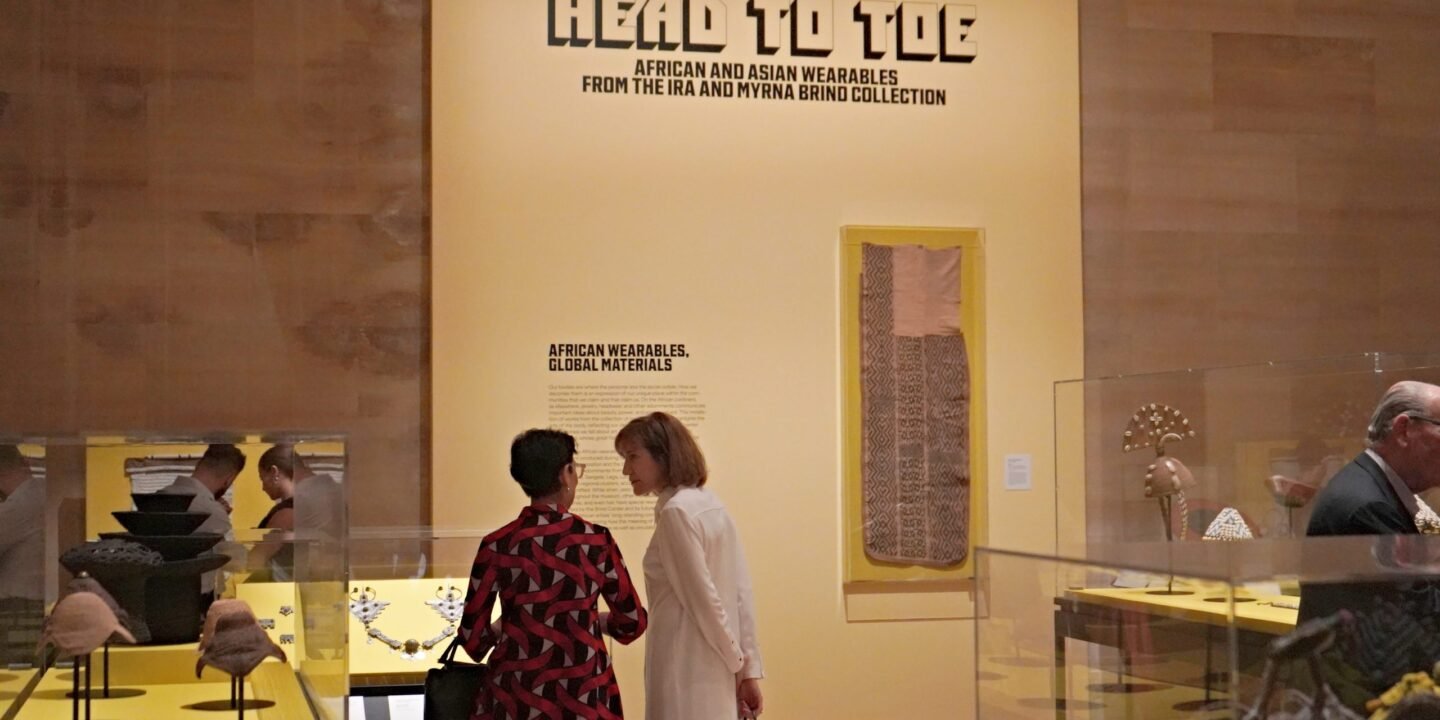
Earlier this month, the Philadelphia Museum of Art presented “Head to Toe: African and Asian Wearables,” a collection of over 50 pieces to help introduce its new Brind Center for African and African Diasporic Art.
The permanent galleries of the Brind Center will open in Fall 2026, with a focus of “expanding the scope and reach of the museum’s collection of art from across Africa, the Americas and the wider African Diaspora.”
The center was established in 2022 by Ira Brind, a member of the museum’s board of trustees, with his wife Stacey Spector. The current collection is in the far end of what will eventually be the permanent gallery of the Brind Center, running along a walkway from the PMA’s forum to the Spring Garden Bridge.
Brind also gifted the collection for “Head to Toe,” which he gathered over half a century with his late wife, Myrna. He described gifting his collection to the museum as a “dream come true.”

“I tried to only collect museum-quality pieces and I didn’t see until Imani [Roach, the center’s director] pointed out to me that there was a direction of the body and of wearables,” Brind said. “I only bought what spoke to me. Masks never spoke to me.”
“What’s most special to me about this collection … is its humanity,” museum CEO Sasha Suda said at a launch event for the collection, which included a performance by Philly drag queen and former “RuPaul’s Drag Race” contestant Sapphira Cristál. “You can go to other large encyclopedic museums — I won’t name any — and they’re full of masks and not these objects. They’re not made for shrines. They’re not removed from day-to-day life, but instead they are wearable art, meant to enhance natural human beauty.”
Roach, the inaugural director for the center and the curator of the African works, said that with the wearables, she focused on key materials that are prominent and important on the African continent, but don’t necessarily get the same level of representation elsewhere in the museum.
“[We’re] really trying to introduce people to the meaning of things,” Roach said. “Like how does raffia [palm] signify in various contexts in Africa? What is the importance of the cowrie shell? What’s the history of glass beads? Those sorts of things.”

The exhibition is organized geographically and in terms of materials. Among the works is a collection of beadwork by Yoruba, a West African ethnic group. One piece is a crimson crown fashioned with glass beads that depicts two chameleons on its top.
Along with the Yoruba works, pieces come from across the continent — South Africa, Kenya, Tunisia, Morocco and the Democratic Republic of Congo.
“That’s an important aspect of the exhibition, to introduce and emphasize the diversity and that obviously Africa is not a country,” Roach said. “It is many nations with hundreds and possibly thousands of various peoples.”

The selection of Asian wearables in the collection, curated by Hiromi Kinoshita, come from ethnic minorities in China, Southeast Asia and Central Asia, rather than the Han works that are typically shown in museums. One item is a butterfly-shaped bridal headdress from the Yao community in China’s Guangxi province, made with lacquered cotton plain weave, bamboo, glass beads and silk yarns.
Connected continents
The shared idea of the side-by-side African and Asian exhibitions is their relation to the human body and thinking about the materials used. Roach said that Kinoshita chose to display wearables partially to emphasize works that aren’t typically shown from their respective areas and historically have been undervalued by western museums.
“There’s been a kind of emphasis often solely on wooden sculpture, when the reality [includes] textile arts, wearables, jewelry that not only show incredible artistry but have deep significance,” Roach said.
Roach pointed out that despite the vast distance of the two continents, silver coinage traveling from one to the other was often recast. Cowrie shells, too, are present in both, though the history and meaning surrounding them differs.
“There is a kind of treasure hunt of connections you can go on … it’s not to conflate them, but it’s to let them exist in parallel,” she said.

The works also highlight another group often underrepresented in the art world: women.
“Oftentimes, beadwork [or] textile work is women’s work, and women artists are underrepresented in museums not only when we’re talking about African material but writ large,” she said. “So I do think that’s a precedent that I’d like to set, to really make sure that the center is also talking about African women’s artistry as well.”
A broader story
When the Brind Center opens fully next year, Roach said that it will tell a broader story about Africa and its diaspora, focused on the people. Photography, costume and textile examples will be added.
“The goal absolutely is not limited to my collection. It is meant to be broad-based. It is meant to be contemporary, modern and go across many different worlds and information,” Brind said.
Brind said that his gift to the center and the museum will eventually total 400 objects — about 60% African, 40% Asian.
Another goal of the center is to bring it out to Philadelphia’s communities in an interactive way before the full space in the museum opens. One initiative to do that will be commissioning an “art-mobile” to transport some of the artworks to local museums and churches.

“I think one of the things that’s going to be really important is to empower Philadelphians to receive the work, to engage the work,” Roach said. “Not to feel like passive receivers of the work, but to really have strong opinions.”
The center’s focus on the African diaspora will include Philly’s place in it.
“The Philadelphia context is an important part of the African diaspora,” Roach said. “Black people in Philadelphia have played an incredible role in the history of this city and also an incredible role in the history of Pan-Africanist movements worldwide … The diaspora is anywhere that African people are or have been, which is really everywhere.”“Head to Toe: African and Asian Wearables” inaugural presentation runs from May 9 to Jan 19, 2026.









